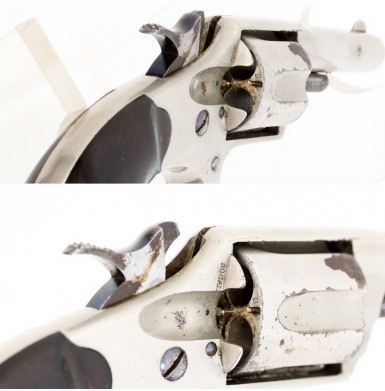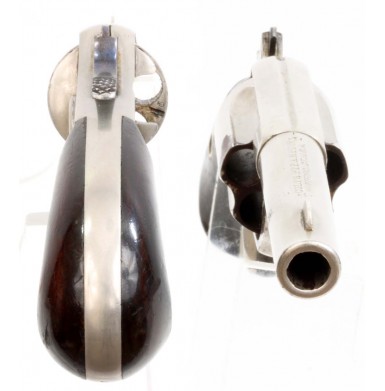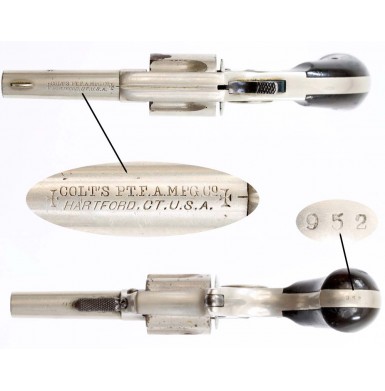At the close of the American Civil War the Colt Patent Firearms Company was aware of two facts that would greatly impact their business practices for the next decade. First, the end of war not only meant no more major US military orders for handguns in the foreseeable future, but it also meant that thousands of surplus US military percussion revolvers would soon be flooding the market, making newly made percussion revolvers difficult (if not impossible) to sell. Second, the day of the percussion revolver was over, and the new self-contained cartridge handgun was the wave of the future. Unfortunately for Colt, Smith & Wesson held the exclusive rights to Rollin White’s patent on the bored-through cylinder, which meant that until that patent expired in 1869 there was no easy way for Colt to manufacture a traditional cartridge revolver without infringing upon that patent. The first of the Colt “bored through cylinder” cartridge revolvers to be offered in 1870, after the expiration of White’s patent, were not alterations of existing models, but were two completely new product lines, the .22RF Colt Open Top and Colt Cloverleaf House pocket revolvers. The Open Top series of arms continued the traditional Colt percussion revolver assembly practice of utilizing three basic parts to assemble the gun, the frame, barrel and cylinder. The Open Top, as the name implied had not top strap and the barrel was secured to the frame with a wedge as it had been with the percussion guns. The Cloverleaf House revolvers, however, utilized a solid frame and top strap with the barrel screwed into the front of the frame. This basic construction technique would become the standard for all future Colt revolver production. With the introduction of Colt’s iconic M-1873 Single Action Army revolver in 1873, it was clear that even though the Open Top and Cloverleaf House series had been rather successful (over 114,000 Open Tops were produced with between 1871 and 1877 and just under 10,000 Cloverleaf House revolvers were manufactured between 1871 and 1876), Colt needed to bring a new series of modern pocket pistols to market that included the various design advancements provided by the Single Action Army, and also to compete with Smith & Wesson, and the numerous cheaply made “Suicide Special” revolvers that were already available for those who were looking to purchase a pocket pistol for protection. The new series of Colt pocket revolvers was dubbed, ironically, the New Line series. These guns were designed by William Mason of Colt, and were covered under US Patent Number 155,095. Mason was the man responsible for many of Colt’s early cartridge revolver designs and alterations. The solid frame New Line series was introduced in 1873 and was available in five frame sizes, dependent upon the five basic chamberings of the gun. The revolvers were actually available in eight different calibers, including .22RF, .30RF and .32, .38 and .41 calibers; either rimfire or centerfire. The guns had five shot cylinders and were available with barrels ranging from about 2 ““ to 10” in length, with the shorter barrels tending to predominate as these were, after all, pocket revolvers. The revolvers were single action, spur trigger affairs, with bird’s head shaped grips to increase their concealability. The standard finish was nickel plating with high luster nitre blued hammer and trigger surfaces and screws. Blued barrels with nickeled frames were available as well as fully blued revolvers and custom finishes including gold and silver washes were also options. Standard grips were two-piece varnished rosewood, but other exotic materials like ebony, mother of pearl and ivory were available for an extra charge as well. Interestingly, walnut, which had been the mainstay of Colt grips since the inception of the company, was rarely used on the New Line revolvers. Most of the New Line revolvers were produced in two models. The “First Model” had shorter cylinder flutes than the “Second Model” and the cylinder locking notches are located behind the flutes on the sides of the cylinder at the rear. The “Second Model” revolvers has much longer flutes, with the locking notches relocated to the rear face of the cylinder. One exception to this rule was the .30 Rimfire New Line revolver, which was only manufactured with the “Second Model” type cylinder, even though this revolver was only produced during the “First Model” period. Most models had their caliber or chambering acid etched onto the left side of the barrel, with the exception of the earliest production larger frame revolvers. As with most pocket pistols of the era, the .22 rimfire variant, with the smallest frame, was the most popular and some 55,343 were manufactured between 1873 and 1877. The .30 rimfire version, with the second smallest frame was only produced for three years, from 1874 to 1876, with some 10,946 being produced. The sized .32 caliber frame was produced from 1873 to 1884, with some 22,000 revolvers being produced in both rimfire and centerfire versions. The next-to largest frame size was chambered for .38 caliber (again in either rim or center fire) and was manufactured from 1874 to 1880 with about 5,500 being manufactured. The .38 caliber guns were serialized in the same range as the largest frame, .41 caliber guns. The .41 caliber revolvers were also available in either rim or center fire versions, with some 9,363 guns being produced between 1874 and 1879. The total production of all frame sizes other than .22 was nearly 10,000 units fewer than the .22 caliber guns alone, attesting to the popularity of the smallest of the New Line family. In the end, it was Colt’s development of the 1877 series of double action revolvers in .32 Colt (Rainmaker), .38 Colt (Lighting) and .41 Colt (Thunderer) that brought production of the New Line revolvers to an end. The new small frame, double action revolvers were such an improvement over the single action spur trigger New Line guns, that the sales dropped of precipitously after the introduction of the 1877 revolvers. As the 1877s were available with short barrels for pocket carry, the customer who wanted a Colt for protection simply bought the new design. The other death knell for the New Line series was the continual influx of cheaply made “Suicide Special” pocket revolvers on the market. Colt simply could not compete price wise with these cheap and often unsafe handguns. As Colt was not willing to sacrifice quality in order to meet the price point of the competitors, they simply could not remain in that market and be economically viable.
Offered here is a NEAR EXCELLENT example of a Colt New Line .30 Rimfire Pocket Revolver. The .30RF variant is unique among Colt firearms in that it is the only revolver produced by Colt that was chambered in .30 caliber. The revolver also had one of the shortest production runs of all Colt handguns, only being manufactured for three years from 1874 to 1876. During that time frame only 10,946 of the .30RF pocket pistols were produced, making the .30 one of the scarcer of the Colt New Lines, twice as rare as a .32 and about five times more scarce than a .22! The revolver is clearly marked with a wonderful acid etched panel on the left side of the barrel: COLT NEW 30. The top of the 2 3/16” long round barrel is clearly roll marked in two lines: COLT’s PT.F.A. Co / HARTFORD, CT. U.S.A.. The barrel address is bracketed by a pair of Maltese Crosses, one at each end. The revolver is also marked with its caliber on the right side of the frame, horizontally behind the recoil shield. There, the revolver is simply marked 30 CAL.. The very low, three-digit serial number 952 is stamped on the bottom of the bird’s head grip frame, and this same number is found stamped on the rear face of the cylinder, one number at a time, between the chambers, as well as under the barrel; concealed by the cylinder arbor pin. Both grip panels are pencil numbered 952 in a period hand on their interior surfaces. This serial number places the revolver in the second half of the first year of production for this model, as some 1,500 of the .30 RF revolvers were produced during 1874. As noted above, the revolver is in about NEAR EXCELLENT condition. It retains about 85%+ of its original nickeled finish overall. The frame and barrel retain about 90%+, with only some minor high edge loss and some small patches of minor flaking and wear. The cylinder shows slightly more flaking than the frame and barrel with two fingernail sized areas of flaked loss between flutes on the front side of the cylinder and an area of speckled flaking and loss on one quarter of the cylinder, likely where the gun laid on a cloth for a long period of time when in storage. There is also a small patch of flaked loss at the rear of the cylinder where the speckled wear is. The nickel has a medium dull milky gray color, a typical patina for mid-19th century nickel finishes. The areas where the nickel has flaked and worn have developed a smooth, dark, chocolate brown patina. The metal is almost entirely smooth and free of any significant pitting, although there is some scattered pinpricking present. The etched panel on the left side of the barrel remains about 90%+ present and fully legible. All markings in the metal are crisp, sharp and fully legible. The top side of the hammer retains about 70%+ vibrant niter blue, with the sides showing a moderately oxidized, mottled brown and gray appearance. The niter blued trigger retains about 50% of its original finish, but has dulled and faded significantly and is not vibrant like the blue found on the hammer. The screws all retain strong traces of their niter blued finish, but show significant dulling and fading. The screws show some moderate slot wear as well. The blued cylinder arbor pin has a faded dusky bluish patina, and the knurling shows some flattening and wear, the result of someone muscling out the pin with the help of pliers. The bore of the revolver is in about FINE overall condition and is mostly bright with crisp rifling, showing only some minor pinpricking along its length and some light pitting near the muzzle. The original German silver front sight is in place on the barrel and is in wonderful condition. The revolver is mechanically FINE and functions correctly on all positions. The revolver indexes, times and locks up exactly as it should. The two-piece rosewood grips are in VERY FINE condition and as noted they are correctly numbered to the revolver. The grips are solid and complete and are free of any breaks, cracks or repairs. They retain about 60%+ of their original varnish, with most of the loss along the high edges and contact points. The grips show some minor surface scuffs and some light bumps and dings from carry, use and storage, but show no signs of abuse.
Overall, this is a really crisp example of one of the less often encountered Colt New Line Revolvers. The gun is 100% complete, correct and original and retains nearly all of its original nickel finish as well as a fine etched panel. With only about 10,000 of these little revolvers manufactured over the three-year period form 1874-1876, it can be difficult to find these diminutive .30 pistols. This is a particularly nice example that is worthy of being added to an advanced New Line collection. This is one of those no excuses revolvers that displays well and is a good value, as you can rarely purchase an old west period Colt revolver for under $600, particularly in this state of condition!
SOLD











